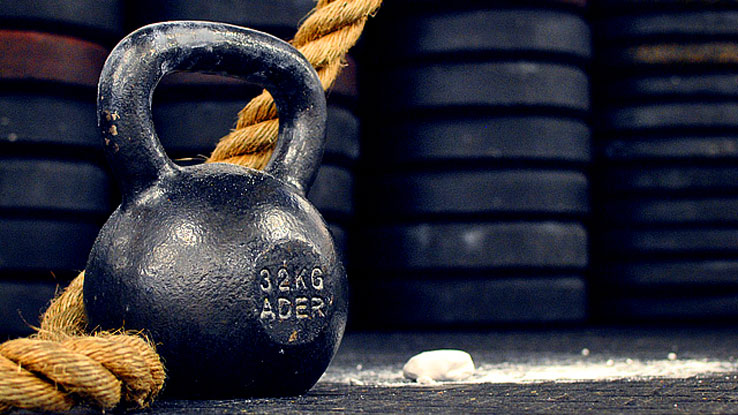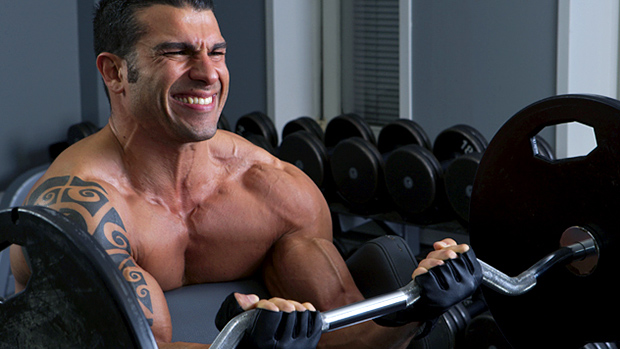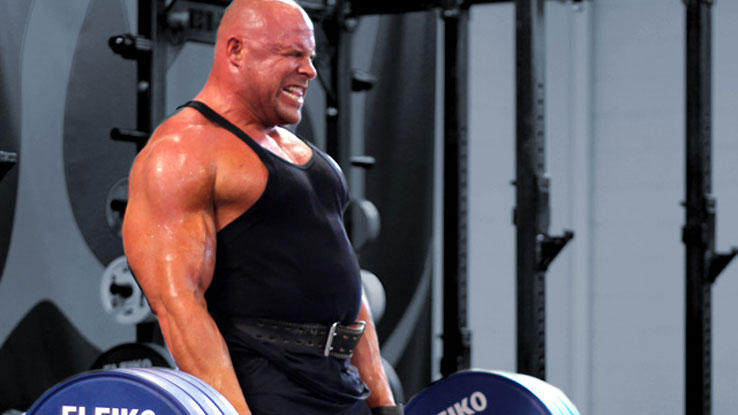You often read about kettlebells as a fat loss and conditioning tool, but what about using them to build serious size and strength?
Every athlete should greatly value strength; it's the foundation upon which all other qualities are built. Strength is a glass. The bigger the glass, the more stuff – power, explosiveness, mobility, flexibility, conditioning, speed, and agility – you can fit in.
The only downside to ridiculous strength is the beating the body must endure while building it. Barbells and dumbbells are wonderful tools, but they're not always forgiving, and many a fledgling lifting career has been cut short by just one momentary lapse of concentration or lack of judgment.
This is where using kettlebells can help. Kettlebells can dramatically reduce the wear and tear on the body while still serving to increase strength, muscle, and power.
For example, powerlifter Donnie Thompson stopped deadlifting altogether, started "kettlebelling," and took his deadlift from 766 to 832 pounds in less than a year.
Granted, if you're a competitive powerlifter or Olympic lifter, then you need to spend time under the bar. But if you're an athlete or physique competitor, I encourage you to explore the lifts presented here.
With kettlebells, you can decrease the training load by up to 75% and still make significant progress in strength, power, and body composition goals. While some may argue that kettlebells put you at a mechanical disadvantage (which is what forces you to use less weight), it really all boils down to tension.
The Central Nervous System (CNS) doesn't know the difference between 300 pounds on your shoulders and 120-pound kettlebells in each hand. The CNS does understand tension though, and if kettlebell training offers any benefit, it's learning how to develop and use full-body tension.
Tension is achieved through high intensity muscle contractions. Greater tension development allows you to generate greater force output while allowing for more efficient control of skeletal muscle.
This is why training with kettlebells can lead to increased numbers in the big lifts. The key is to learn how to efficiently generate tension within each lift.
My best back squat was 390 pounds and my best front squat at that time was mid-200's – and now double 24-pound kettlebells crush me on a regular basis.
Have I gotten weaker? Not at all. Double kettlebell front squats are just really that hard. Ask anyone who's ever tried to put half their front squat weight in each hand with kettlebells if it felt the same – I guarantee you'll get a resounding no.
Holding two heavy kettlebells requires focus, a strong upper body, and strong legs. But the reward is a pair of impressive wheels.
To generate tension in the kettlebell front squat, the alignment of the pelvis is critical. After the kettlebells have been cleaned into the rack position, a posterior pelvic tilt should be performed to ensure proper alignment.
Once the pelvis has been set, drive your heels into the ground (while maintaining contact through the entire foot) and screw your feet into the ground. This should lead to an increased arch in the mid foot and external rotation of the femurs.
Crush the handles of the kettlebell and develop lat tension by imagining pencils in your armpits that you're trying to snap in half. The scapula should be depressed and slightly protracted.
Take a deep belly breath and pull yourself into the bottom of the squat. Maintain tension throughout the entire movement and initiate the ascent with a forceful grunt and exhalation.
Key Points
- Clean the kettlebells into the rack position or have a partner assist you.
- Maintain a neutral spine and pull yourself into the squat. Imagine pulling your knees to your chest instead of lowering yourself.
- Hips and shoulders ascend simultaneously.
The double kettlebell military press requires intense focus and tension through the whole body. Tight glutes (posterior pelvic tilt), breathing behind the shield (diaphragmatic breathing with a brace), and lat tension (grip and breaking the pencils in your arm pits) are all musts in this lift.
If we look at the construct of the kettlebell versus the dumbbell, the kettlebell's line of resistance falls straight through the forearm while the dumbbell's falls outside of the wrists on each side. This allows for better loading of the deltoid with the kettlebell. The kettlebell also increases the demand on the external rotators of the shoulder in order to stabilize the weight at the top of the press.
Key Points
- Clean the kettlebells into the rack position or have a buddy assist you.
- Maintain a neutral spine and pelvic alignment, tense the glutes and lats, and use breathing behind the shield throughout the lift.
- Sharp inhalation of air before the lift and a forceful exhalation as the kettlebell is being pressed.
- Avoid arching the lower back and allowing the rib cage to rise as you near the top of the press.
- Actively pull the kettlebells back down by using the lats.
Olympic lifters have some of the most impressive physiques in the sporting world thanks in part to the many cleans and snatches they do. What makes these lifts such great muscle-building exercises is that they can't be narrowed down to one particular muscle group being worked.
However, the problem with barbell cleans and snatches is that there's a very high learning curve coupled with extreme mobility demands. One must have very mobile wrists, thoracic spine, hips, ankles, and a near perfect overhead squat – a tall order for most everyday lifters.
While there are mobility demands and a learning curve to the kettlebell clean and snatch, it's much lower than the barbell variations but with just as much benefit.
But they're still a butt-kicker – watch anyone perform heavy double cleans and snatches and you'll see a level of savagery not found in many lifts. A forceful hip snap and quick bracing of every muscle in the body during the top portion of the lifts, followed by a massive eccentric loading of the glutes, lats, and arms.
The kettlebell also holds a few advantages over the barbell variations. With kettlebells, the weight can be swung between the legs, increasing the eccentric load and leading to more powerful hips. Kettlebells can also be used for many reps without stressing the wrists. Not to mention, unlike the barbell lifts, which tend to degrade in quality with each successive rep, kettlebell cleans and snatches seem to get better with more reps.
Key Points
- Ensure that you lock your arm out overhead with a neutral wrist at the top of the kettlebell snatch.
- At the top of the snatch, slowly lower the bells to chest level (rack position), and swing them back between your legs to begin the next rep.
- During the clean, finish in the rack position with your arms pressing tight against your torso. This position enables you to safely absorb the shock when cleaning the kettlebells.
- Keep your elbows tight to your body as you clean the bells into the rack position.
- As with all the lifts, maintain a neutral spine.
- Avoid excessive arching of the low back at the top of the snatch. Finish with your hips all the way through and avoid allowing your rib cage to flair up and out.
- I strongly suggest addressing your double bell swing before getting into the clean and snatch as the clean and snatch are both simply swing variations. If you feel like your clean or snatch is "off," go back and make sure your swing is efficient.
The aim here wasn't to dismiss the barbell variations, but to simply offer alternatives that have similar movement patterns albeit with a different implement.
The double kettlebell lifts allow for decreased systemic load (less stress + better recovery = more frequent training), a better line of resistance, and increased range of motion, allowing for greater eccentric loading.
In short, double kettlebell lifts are a worthy investment.
- Powers S et al. Exercise physiology: Theory and application to fitness and performance. (8th ed., p. 572). New York, NY: McGraw Hill. 2012.





